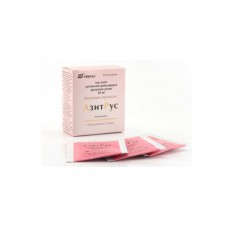Expiration date: 11/2026
Release form and composition:
Capsules gelatine, yellow color, No. 0 contents of capsules - pellets white, or almost white.
1 capsule contains:
azithromycin (in the form of dihydrate) 250mg
Auxiliary substances: povidone (polyvinylpyrrolidone), calcium stearate, microcrystalline cellulose.
Composition of gelatin capsules: titanium dioxide, methylhydroxybenzoate, propylhydroxybenzoate, acetic acid, gelatin.
6 PCs. - packaging sells contoured (1) - packs of cardboard.
Powder for the preparation of the suspension for ingestion of white or almost white, with an orange smell prepared suspension-uniform, white with a yellowish tinge.
1 pack contains:
azithromycin (in the form of dihydrate) 50, 100 or 200mg
Auxiliary substances: sodium citrate (sodium citrate translesanas), orange flavor food, sodium saccharin, kollidon CL-M (crospovidon), sucrose.
Azitrus ® Forte
Tablets covered with a film cover of white or white with a yellowish tinge of color, oval.
1 tablet contains:
azithromycin (in the form of dihydrate) 500 mg
Auxiliary substances: calcium stearate, starch 1500, potato starch, crospovidon (kollidon CL-M), povidone (polyvinylpyrrolidone), lactose, talc, cellulose microcrystalline.
The composition of the shell: hypromellose (oksipropilmetiltselljuloza), macrogol (polyethylene oxide 4000, polyethylene glycol 4000), titanium dioxide (titanium dioxide).
Pharmacological action:
The broad-spectrum antibiotic from macrolides group, ozalid. Acts bacteriostatically. Binding to 50S-subunit of ribosomes, inhibits protein synthesis and slows the growth and reproduction of bacteria. In high concentrations has a bactericidal effect. It acts on extracellular and intracellular pathogens.
Active against gram-positive microorganisms: Streptcccus spp. (groups C, F and G, except for resistant to erythromycin), Streptcccus pneumniae, Streptcccus pygenes, Streptcccus agaactiae, Streptcccus viridans, epidermidis Staphycccus, Staphycccus aureus gram negative bacteria: Haemphius infuenae, Mraxea catarrhais, Brdetea pertussis, parapertussis Brdetea, Leginea pneumphia, Haemphius ducreyi, Campybacter jejuni, Neisseria gnrrheae and Gardnerea vaginais some anaerobic microorganisms: Bacterides bivius, Cstridium perfringens, Peptstreptcccus spp. and also intracellular pathogens: Chamydia trachmatis, Chamydia pneumniae, Mycpasma pneumniae, Mycbacterium avium cmpex, Ureapasma ureayticum, Trepnema paidum, Brreia burgdferi.
Azithromycin is not active against gram-positive bacteria resistant to erythromycin.
Pharmacokinetics:
Suction
After taking the drug inside azithromycin is rapidly absorbed from the gastrointestinal tract due to its stability in acidic medium and lipophilicity. Once inside the dose of 500 mg Cmax in plasma achieved through 2.5-2.9 h and is 0.4 mg/l. Bioavailability is 37.5%.
Distribution
Azithromycin is rapidly distributed throughout the body, with high concentrations of antibiotic in tissues. It penetrates well into the respiratory tract, organs and tissues of the urogenital tract (in particular, the prostate gland), into the skin and soft tissues. High concentration in tissues (10-50 times higher than in blood plasma) and long T1/2 due to low binding of azithromycin to plasma proteins of blood, as well as its ability to penetrate into eukaryotic cells and concentrate in an environment with low pH, environmental lysosomes. This in turn determines the large apparent Vd (31.1 l/kg) and the high plasma clearance. The ability of azithromycin to accumulate mainly in lysosomes is especially important for the elimination of intracellular pathogens. It is proved that phagocytes deliver azithromycin to the sites of infection localization, where it is released in the process of phagocytosis. The concentration of azithromycin in the foci of infection is significantly higher than in healthy tissues (on average 24-34%) and correlates with the degree of inflammatory edema. Despite the high concentration in phagocytes, azithromycin has no significant effect on their function.
Azithromycin remains in bactericidal concentrations in inflammation within 5-7 days after the last dose, which allowed to develop a short (3-day and 5-day) courses of treatment.
Metabolism
Azithromycin is metabolized in the liver by demethylation to form inactive metabolites.
Breeding
Removal of azithromycin from blood plasma takes place in 2 stages: T1/2 is 14-20 h in the range of 8 to 24 h after taking the drug and 41 h – in the range of 24 to 72 h, which allows the drug 1 time/day.
Excreted mainly jelchew in an unmodified form, a small part is excreted by the kidneys.
Indications:
Infectious and inflammatory diseases caused by microorganisms sensitive to the drug:
- infections of the upper respiratory tract and ENT organs (angina, sinusitis, tonsillitis, pharyngitis, otitis media)
- scarlatina
- infections of the lower respiratory tract (bacterial, including caused by atypical causative agents of pneumonia, exacerbation of chronic pneumonia, bronchitis)
- infections of the skin and soft tissues (erysipelas, impetigo, secondary infected dermatoses)
- urinary tract infection (gonorrheal urethritis and degeneracy)
- infection of the female genital organs (cervicitis)
- Lyme disease (borreliosis) in the initial stage (erythema migrans)
- diseases of the stomach and duodenum associated with Heicbacter pyri (as part of combination therapy).
Dosage regimen:
The drug is taken orally 1 times/day for 1 hour before or 2 hours after a meal.
Adults
In infections of the upper and lower respiratory tract appoint 500 mg / day for 3 days (course dose — 1.5 g).
In infections of the skin and soft tissues appoint 1 g/day in the 1st day, then 500 mg daily from the 2nd to the 5th day (course dose-3 g).
In uncomplicated urethritis and/or cervicitis appoint one 1 g.
In Lyme disease (borreliosis) for the treatment of the initial stage (erythema migrans) appoint 1 g in the 1st day and 500 mg daily from the 2nd to the 5th day (course dose-3 g).
When ulcers stomach and duodenal ulcers associated with Heicbacter pyri, appoint 1 g/day for 3 days in combination therapy of H. pylori.
Children
The drug is prescribed in the form of capsules for children over 3 years and/or weighing more than 25 kg with infections of the upper and lower respiratory tract, skin and soft tissues at the rate of 10 mg/kg body weight 1 time/day for 3 days (course dose - 30 mg/kg), or on the 1st day-10 mg/kg , then for 4 days - 5-10 mg/kg / day.
In the treatment of the initial stage (erythema migrans) Lyme disease (borreliosis), the drug is prescribed at a dose of 20 mg/kg on the 1st day, then 10 mg/kg from the 2nd to the 5th day.
The drug in the form of a suspension for oral administration is prescribed to children older than 6 months with infections of the upper and lower respiratory tract, skin and soft tissues at the rate of 10 mg/kg body weight 1 time/day for 3 days (course dose - 30 mg/kg), or for 5 days: on the 1st day-10 mg/kg, then for 4 days - 5-10 mg/kg/day.
The recommended doses of the drug, depending on the body weight of the child are presented in the table.
| Body weight | Average daily (single) dose |
| Powder for preparation of oral suspension 100 mg/5 ml | |
| 5 kG | 2.5 ml (50 mg) |
| 6 kG | 3 ml (60 mg) |
| 7 kG | 3.5 ml (70 mg) |
| 8 kG | 4 ml (80 mg) |
| 9 kG | 4.5 ml (90 mg) |
| 10-14 kG | 5 ml (100 mg) |
| Powder for suspension 200 mg/5 ml | |
| 15-24 kG | 5 ml (200 mg) |
| 25-34 kG | 7.5 ml (300 mg) |
| 35-44 kG | 10 ml (400 mg) |
| from 45 kG | assign doses to adults (500-1000 mg) |
In the treatment of the initial stage (erythema migrans) Lyme disease (borreliosis), the drug is prescribed at a dose of 20 mg/kg on the 1st day, then 10 mg/kg from the 2nd to the 5th day.
Rules for preparing an oral suspension
Single-dose packet
In a clean Cup pour a small amount of boiled and chilled water, then pour the contents of one package and stirred until a homogeneous suspension. After taking the Cup should be washed with water, dried and stored in a dry and clean place.
Drug Azitrox® Forte (tablets, film-coated) is prescribed to children over 12 years of age and/or weighing more than 50 kg when infections of the upper and lower respiratory tract, skin and soft tissue 500 mg 1 times/day for 3 days (course dose — 1.5 g).
In the treatment of erythema migrans in children (over 12 years and/or weighing more than 50 kg) Azitrus® Forte appoint 1 g/day on the 1st day and 500 mg daily from 2 to 5-day (course dose-3 g).
Side effect:
From the digestive system: possible-diarrhea (5%), nausea (3%), abdominal pain (3%) e 1% — flatulence, vomiting, melon, cholestatic jaundice, increased activity of hepatic transaminases in children — constipation, decreased appetite, gastritis, candidiasis of the oral mucosa, taste change (e 1%).
From the side of cardiovascular system: palpitations, chest pain (e 1%).
From the Central nervous system: dizziness, headache, drowsiness in children — headache (in the treatment of otitis media), hyperkinesia, anxiety, neurosis, sleep disorders (e 1%).
From the urinary system: jade (e 1%).
From the genital system: vaginal candidiasis.
Allergic reactions: rash, urticaria, itching, angioedema in children - conjunctivitis, itching, urticaria.
Other: asthenia, photosensitization.
Contraindications:
- renal failure
- liver failure
- lactation (breastfeeding)
- children under 6 months of age (for suspension)
- children under 3 years old and / or under 25 kg body weight (for capsules)
- children under 12 years old and / or under 50 kg body weight (for film-coated tablets)
- hypersensitivity to the components of the drug, as well as to other macrolides.
With caution, prescribe the drug to patients with cardiac arrhythmias (possible ventricular arrhythmias, prolongation of THE Qt interval), children with severe renal or liver disorders, during pregnancy.
Pregnancy and lactation:
The use of the drug during pregnancy is only possible when the intended benefit to the mother exceeds the potential risk to the fetus.
If necessary, the use of the drug during lactation breastfeeding should be stopped.
Special instruction:
The drug is not taken during a meal.
In case of admission, the missed dose should be taken as soon as possible, and the following - at intervals of 24 hours.
It is necessary to observe a break of at least 2 hours between the drug Azitrus® and antacid drugs.
After discontinuation of the drug hypersensitivity reactions in some patients may persist, in such cases, it is recommended to prescribe specific therapy under the supervision of a doctor.
Overdose:
Symptoms: nausea, temporary hearing loss, vomiting, diarrhea.
Treatment: gastric lavage, symptomatic therapy.
Drug interaction:
With the simultaneous use of antacids (aluminum - and magnesium-containing), ethanol and food slow down and reduce the absorption of azithromycin.
In a joint application of azithromycin at therapeutic doses of warfarin, changes in prothrombin time were noted, however, that the interaction of macrolides with warfarin may increase anticoagulant effect, when you assign this combination to patients requires careful monitoring of prothrombin time.
With simultaneous use increases the concentration of digoxin in blood plasma.
With simultaneous use, the toxic effect (vasospasm, dysesthesia) of ergotamine and dihydroergotamine increases.
While the use of reduced clearance and enhanced pharmacological effect of triazolama.
Azithromycin inhibits microsomal oxidation in hepatocytes, which leads to slower excretion and higher concentration in plasma and toxicity zikloserina, indirect anticoagulants, methylprednisolone, felodipine, and drugs undergoing microsomal oxidation (carbamazepine, terfenadine, cyclosporine, gexobarbitala, ergot alkaloids, valproic acid, disopyramide, bromocriptine, phenytoin, oral gipoglikemicakie means, xanthine derivatives, including theophylline).
Lincosamine reduce the effectiveness of azithromycin.
Tetracycline and chloramphenicol enhance the efficacy of azithromycin.
Storage conditions and terms:
List B. the Drug should be stored out of reach of children, dry, protected from light place at temperature not exceeding 25°C. shelf Life – 2 years.




